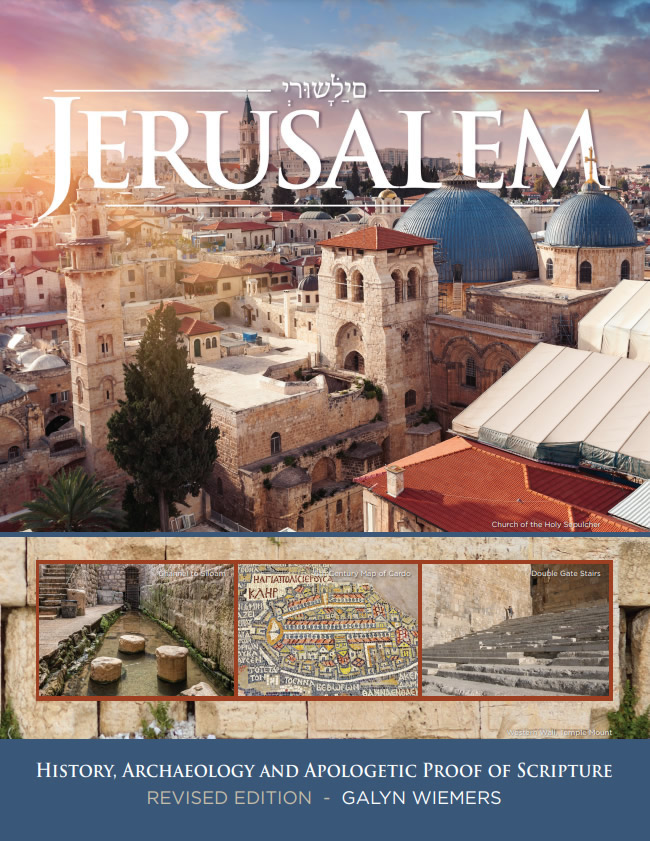| 11- Hinnom Valley | ||||
The Hinnom Valley is also called “the valley of the son of Hinnom” or “Valley of Benhinnom.” This was shortened to “Valley Hinnom” which in Hebrew is pronounced, “Ge Hinnom” and transliterated into Greek as “Gehenna.” Thus, the Hinnom Valley is the Gehenna of the New Testament, which is associated with fire, judgment, the Lake of Fire, eternal fire and Hell. The border for the land allotted to the tribe of Judah is partially identified with this valley by Joshua in 1400 BC:
At its lowest point, the Hinnom Valley is also the lowest point in the city of Jerusalem. If the Temple Mount on Mount Moriah is the highest point in the city and represents the presence of the Lord, then the lowest point of the city would also have illustrative value. This can be seen by comparing Amos and Isaiah’s use of topographical typology:
|
||||
 |
||||
| Click above image to open a large view. | ||||
 |
||||
| Standing in the Hinnom Valley outside Jerusalem to the south looking up at the rising mount that becomes Jerusalem. | ||||
Today the Hinnom Valley is covered with green grass. This photo was taken on the west side of the Mount Zion near the southwest corner of the Old City walls. An Arab family is resting in the shade of a tree while their children play in the Hinnom Valley. |
||||
Add to this the geographical fact that the wilderness began where the Hinnom Valley ended, and we have a perfect illustration of the realm of demons (Leviticus 16:10) and the chaos that was conquered (Genesis 1:2, 3). When the people of Judah began to worship demons and offer their children in the fire, they did it in the Hinnom Valley. When Josiah became king, he went down into the Hinnom Valley where children had been sacrificed to demons, and he desecrated the altar/
When God spoke through Isaiah of the coming judgment he also spoke of “the burner”:
|
||||
The Hinnom Valley had become a place associated not only with the lowest point and the path to the wilderness of demonic chaos, but also as a place of
Likewise, James, Jesus’ brother, writing from Jerusalem around 48 AD says of the tongue:
The slopes of the Hinnom Valley were used for tombs by the wealthiest Jewish families in the first century. Josephus says the tomb of Annas the high priest is |
||||
 |
||||
| In the Hinnom Valley among olive trees south of Jerusalem near where the Kidron Valley joins the Hinnom Valley SE of Jerusalem. En Rogel, the location where David's son Adonijah attepted to be declared king before Solomon was declared king at the Gihon Springs a little further up the Kidron Valley to the north, is near the spot where the Hinnom and Kidron Valley's meet. | ||||
 |
||||
| En Rogel is near where "KIDRON VALLEY" is written on the above photo. | ||||
 |
||||
| West of the city of Jerusalem the Hinom Valley runs north and south before it turns east to join the Kidron Valley south and southeast of Jerusalem. | ||||
Looking south down the Hinnom Valley in the evening outside the Joppa Gate and the west wall of the city. The Citadel can be seen in the top left corner of this photo. |
||||
Looking west over the Hinnom Valley from what is called Mount Zion today. The King David Hotel sits at the top in the middle of this photo. |
||||
Looking down into the Hinnom Valley from on top of Mount Zion near Jerusalem University College. |
||||
|
 |
UPDATED! 2022 - JERUSALEM: HISTORY, ARCHAEOLOGY AND APOLOGETIC PROOF OF SCRIPTURE - Revised Edition (2022) Open this link (https://generationword.com/Jerusalem-History_Archaeology_Apologetic_Proof_of_Scripture-Revised_Edition-2022.htm)
|
Original 2010 - JERUSALEM: HISTORY, ARCHAEOLOGY AND APOLOGETIC PROOF OF SCRIPTURE Download a FREE online .pdf of "Jerusalem" HERE (click on this book cover to download the 2010 book as a .pdf ) |
|
|
|
|
|